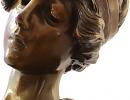Contact Seller
Antique Ethos
Tel07841679518Please quote Antiques Atlas.


 Quality antique Japanese satsuma jardiniere
Quality antique Japanese satsuma jardiniere
 Small Vintage Satsuma Vase, Chinese, Ceramic
Small Vintage Satsuma Vase, Chinese, Ceramic
 Quality antique Japanese Satsuma ginger jar
Quality antique Japanese Satsuma ginger jar
 Large Japanese Satsuma Vase 159cm
Large Japanese Satsuma Vase 159cm
 Tall Pair Of Vintage Satsuma Vases, Japanese
Tall Pair Of Vintage Satsuma Vases, Japanese
 Antique Japanese satsuma three piece tea set
Antique Japanese satsuma three piece tea set
 Satsuma Vases Enamelled Large Pair Damaged Tops
Satsuma Vases Enamelled Large Pair Damaged Tops
 Meiji period Satsuma vase signed
Meiji period Satsuma vase signed
 Antique Japanese quality satsuma hand painted vase
Antique Japanese quality satsuma hand painted vase
 Pair of antique quality Japanese satsuma plates
Pair of antique quality Japanese satsuma plates
 A Pair of Satsuma Meiji Period Ovoid Vases
A Pair of Satsuma Meiji Period Ovoid Vases
 Satsuma Vase
Satsuma Vase
Non UK callers :
+44 7841679518
Pair of Small Meiji Satsuma Vases by Hododa c1890


Exquisitely decorated small pair of Meiji period Japanese Satsuma vases signed Hododa c1880. The vases are of footed hexagonal form with waisted neck and everted rim. Delicate ivory coloured ground with characteristically crackled transparent glaze. Finely overpainted with figural panels of garden scenes with kimono-clad female groups to one side and court related scenes to other. Detailed stylised floral and foliate painted decoration to borders and to shoulder. Painted signature to base for Hododa under the circular Shimazu clan mark. The vases are approximately 11.5 cm in height.
This pair of vases are in excellent condition commensurate with age. No cracks, chips or restoration. Crackle-crazed ground that is characteristic of Satsuma ware. Some rubbing to gilt on high points. Please see images as these form an important part of the description.
Prior to 1852 Japanese rulers followed a policy called Sakoku (closed country) which banned international travel and commerce. The USA, seeing benefit in open commercial trade, forced Japan to open-up its borders to Western countries. This resulted in the first major presentation of Japanese arts to the West at the Paris Exposition Universelle in 1867 – where items from the Satsuma province were showcased. These decorative items received great acclaim – driving the emergence of Japonism as a major influence on the Aesthetic Movement and subsequently on the Art Nouveau Movement. Rulers of Satsuma (the Shimazu clan) were quick to capitalise on this emerging popularity of Japanese ceramics. Satsuma production was expanded with producers adapting traditional nishikide Satsuma to create an export style that was thought to reflect foreign tastes. By 1873, ‘etsuke’ workshops specializing in decorating blank-glazed stoneware items from Satsuma had sprung up in Kobe and Yokohama. In places such as Kutani, Kyoto and Tokyo, workshops made their own blanks, eliminating any actual connection with Satsuma. By the early 1920s “Satsuma” had gone from being a mark of geographical origin to conveying an aesthetic – with more than twenty etsuke factories across Japan producing “Satsuma ware” of varying quality, as well as a number of independent studios still producing high-quality pieces. Viewing welcomed - please contact us in advance.
Secure payment by debit/credit card is available via our website (see our Dealer's page here on Antiques Atlas for link).
SellerAntique Ethos
View all stock from
Antique Ethos

 Private dealer
Private dealer
By appointment only
Durham
County Durham
Tel : 07841679518
Non UK callers : +44 7841679518
This pair of vases are in excellent condition commensurate with age. No cracks, chips or restoration. Crackle-crazed ground that is characteristic of Satsuma ware. Some rubbing to gilt on high points. Please see images as these form an important part of the description.
Prior to 1852 Japanese rulers followed a policy called Sakoku (closed country) which banned international travel and commerce. The USA, seeing benefit in open commercial trade, forced Japan to open-up its borders to Western countries. This resulted in the first major presentation of Japanese arts to the West at the Paris Exposition Universelle in 1867 – where items from the Satsuma province were showcased. These decorative items received great acclaim – driving the emergence of Japonism as a major influence on the Aesthetic Movement and subsequently on the Art Nouveau Movement. Rulers of Satsuma (the Shimazu clan) were quick to capitalise on this emerging popularity of Japanese ceramics. Satsuma production was expanded with producers adapting traditional nishikide Satsuma to create an export style that was thought to reflect foreign tastes. By 1873, ‘etsuke’ workshops specializing in decorating blank-glazed stoneware items from Satsuma had sprung up in Kobe and Yokohama. In places such as Kutani, Kyoto and Tokyo, workshops made their own blanks, eliminating any actual connection with Satsuma. By the early 1920s “Satsuma” had gone from being a mark of geographical origin to conveying an aesthetic – with more than twenty etsuke factories across Japan producing “Satsuma ware” of varying quality, as well as a number of independent studios still producing high-quality pieces. Viewing welcomed - please contact us in advance.
Secure payment by debit/credit card is available via our website (see our Dealer's page here on Antiques Atlas for link).
Price The price has been listed in British Pounds.
Conversion rates as of 2/MAY/2024. Euro & Dollar prices will vary and should only be used as a guide.
Always confirm final price with dealer. SOLD
Date c1890
Late 19th Century Antiques Material Ceramic
Origin Japanese
Item code as930a413 / OC145
Status Sold
£0 
$0.00 
€0.00 

$

€

Conversion rates as of 2/MAY/2024. Euro & Dollar prices will vary and should only be used as a guide.
Always confirm final price with dealer. SOLD
Shipping information
Free standard delivery to the UK (4-6 working days) for smaller items – excluding mantle clocks and all furniture as well as larger/fragile ceramics and glass. Please contact us for delivery costs outside the UK and for excluded items. We will provide quotes for delivery options valid for three days. Items will be reserved for this period. For full delivery details visit the information page on our website (see our Antiques Atlas dealer page for link).
Terms and conditions
Please visit the information page on our website for our full terms and conditions (see our Antiques Atlas dealer page for link).
View all stock from
Antique Ethos

 Private dealer
Private dealerBy appointment only
Durham
County Durham
Tel : 07841679518
Non UK callers : +44 7841679518
You may also be interested in
 Quality antique Japanese satsuma jardiniere
Quality antique Japanese satsuma jardiniere
 Small Vintage Satsuma Vase, Chinese, Ceramic
Small Vintage Satsuma Vase, Chinese, Ceramic
 Quality antique Japanese Satsuma ginger jar
Quality antique Japanese Satsuma ginger jar
 Large Japanese Satsuma Vase 159cm
Large Japanese Satsuma Vase 159cm
 Tall Pair Of Vintage Satsuma Vases, Japanese
Tall Pair Of Vintage Satsuma Vases, Japanese
 Antique Japanese satsuma three piece tea set
Antique Japanese satsuma three piece tea set
 Satsuma Vases Enamelled Large Pair Damaged Tops
Satsuma Vases Enamelled Large Pair Damaged Tops
 Meiji period Satsuma vase signed
Meiji period Satsuma vase signed
 Antique Japanese quality satsuma hand painted vase
Antique Japanese quality satsuma hand painted vase
 Pair of antique quality Japanese satsuma plates
Pair of antique quality Japanese satsuma plates
 A Pair of Satsuma Meiji Period Ovoid Vases
A Pair of Satsuma Meiji Period Ovoid Vases
 Satsuma Vase
Satsuma Vase







